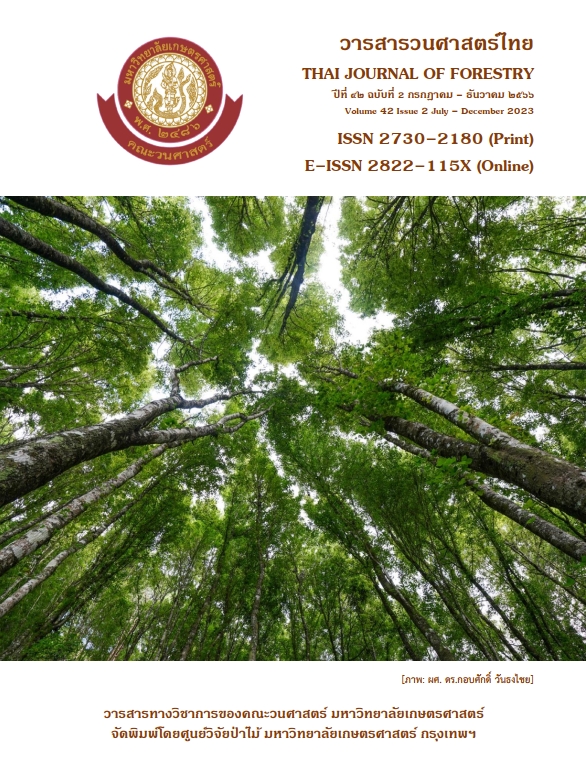โครงสร้างทางสังคมของแมลงผิวดินบริเวณสวนพฤกษศาสตร์วังน้ำเย็น จังหวัดสระแก้ว
Main Article Content
บทคัดย่อ
การศึกษาโครงสร้างทางสังคมของแมลงผิวดิน ได้ทำการสำรวจในพื้นที่สวนพฤกษศาสตร์วังน้ำเย็น จังหวัดสระแก้ว โดยแบ่งพื้นที่ศึกษาออกเป็น 3 พื้นที่ ได้แก่ ป่าธรรมชาติ พื้นที่ปลูกไม้วงศ์ถั่ว และสวนสมุนไพร ทำการเก็บตัวอย่างแมลงผิวดินโดยใช้กับดักหลุม (pitfall–trap) และกับดักถุงผ้า (Winkler extractor) ทำการเก็บตัวอย่างทุก 2 เดือน เป็นเวลา 1 ปี ตั้งแต่เดือนพฤษภาคม 2565–เมษายน 2566 ผลการศึกษาพบแมลงทั้งสิ้น 273 ชนิด 75 วงศ์ จาก 12 อันดับ ซึ่งแมลงในอันดับ Hymenoptera พบจำนวนชนิดมากที่สุด 84 ชนิด รองลงมาเป็นอันดับ Coleoptera และอันดับ Diptera จำนวน 70 และ 34 ชนิด ตามลำดับ ค่าดัชนีความหลากหลายทางชนิด (species diversity index) ในพื้นที่ป่าธรรมชาติมากที่สุด รองลงมาเป็นพื้นที่ปลูกไม้วงศ์ถั่ว และพื้นที่สวนสมุนไพร มีค่าเท่ากับ 4.49, 4.47 และ 4.45 ตามลำดับ ในการวิเคราะห์ค่าดัชนีความสม่ำเสมอ พบว่า มีค่าความสม่ำเสมออยู่ในช่วง 0.79–0.80 ส่วนค่าดัชนีความคล้ายคลึงของแมลง พบว่าทุกพื้นที่มีค่าความคล้ายคลึงในระดับปานกลางอยู่ระหว่าง 0.58–0.64 โดยในฤดูฝนพบชนิดแมลงผิวดินมากกว่าฤดูแล้ง จำนวน 234 และ 158 ชนิด ตามลำดับ เมื่อวิเคราะห์ความสัมพันธ์ระหว่างปัจจัยแวดล้อมกับชนิดแมลงในแต่ละพื้นที่ พบว่าความชื้นดินและฤดูกาลมีความสัมพันธ์กันอย่างมีนัยสำคัญทางสถิติ (p<0.05) กับจำนวนชนิดแมลงผิวดิน แสดงให้เห็นว่าความชื้นและฤดูกาลมีผลต่อสังคมของแมลงผิวดิน
Downloads
Article Details

อนุญาตภายใต้เงื่อนไข Creative Commons Attribution-NonCommercial-NoDerivatives 4.0 International License.
ข้าพเจ้าและผู้เขียนร่วม (ถ้ามี) ขอรับรองว่า ต้นฉบับที่เสนอมานี้ยังไม่เคยได้รับการตีพิมพ์และไม่ได้อยู่ในระหว่างกระบวนการพิจารณาตีพิมพ์ลงในวารสารหรือสิ่งตีพิมพ์อื่นใด ข้าพเจ้าและผู้เขียนร่วม (ถ้ามี) ยอมรับหลักเกณฑ์และเงื่อนไขการพิจารณาต้นฉบับ ทั้งยินยอมให้กองบรรณาธิการมีสิทธิ์พิจารณาและตรวจแก้ต้นฉบับได้ตามที่เห็นสมควร พร้อมนี้ขอมอบลิขสิทธิ์ผลงานที่ได้รับการตีพิมพ์ให้แก่วารสารวนศาสตร์ คณะวนศาสตร์ มหาวิทยาลัยเกษตรศาสตร์ กรณีมีการฟ้องร้องเรื่องการละเมิดลิขสิทธิ์เกี่ยวกับภาพ กราฟ ข้อความส่วนใดส่วนหนึ่ง หรือ ข้อคิดเห็นที่ปรากฏในผลงาน ให้เป็นความรับผิดชอบของข้าพเจ้าและผู้เขียนร่วม (ถ้ามี) แต่เพียงฝ่ายเดียว และหากข้าพเจ้าและผู้เขียนร่วม (ถ้ามี) ประสงค์ถอนบทความในระหว่างกระบวนการพิจารณาของทางวารสาร ข้าพเจ้าและผู้เขียนร่วม (ถ้ามี) ยินดีรับผิดชอบค่าใช้จ่ายทั้งหมดที่เกิดขึ้นในกระบวนการพิจารณาบทความนั้น”
เอกสารอ้างอิง
Academic Affair and Planning Bureau. 2017. Utilization of On-Farm Forest by Farmers in the Northeast of Thailand. Agricultural Land Reform Office, Bangkok, Thailand. (in Thai)
Anderson, A.N. 1997. The ants as bioindicators of ecosystem restoration following mining: A functional group approach. In: Hale, P., Lamb, D. (Eds). Convention Outside Nature Reserves. Centre for Conservation Biology, The University of Queensland, pp. 319-325.
Andersen, A.N., Hoffmann, B.D., Muller, W.J., Griffiths, A.D. 2002. Using ants as bioindicator in land management: simplifying assessment of ant community responses. Journal of Applied Ecology, 39(1): 8-17.
Culliney, T.W., 2013. Role of arthropods in maintaining soil fertility. Agriculture, 3(4): 629-659.
Forest and Plant Conservation Research Office. 2016. Methods of Studying Insect Biodiversity. Department of National Parks, Wildlife and Plant Conservation, Bangkok, Thailand. (in Thai)
Gajaseni, J. 1976. An Ecological Study on Population, Biomass and Species Composition of Soil Fauna in Dry Evergreen Forest, Sakaerat, Nakhon Ratchasima. M.S. Thesis, Chulalongkorn University, Bangkok, Thailand. (in Thai)
Hölldobler, B., Wilson, E.O. 1990. The Ants. Springer-Verlag, Berlin, Germany.
Jaitrong, W. 2011. Key to the Ant Genera in Thailand. Natural History Museum of the National Science Museum, Ministry of Science and Technology, Pathum Thani, Thailand. (in Thai)
Jetanajit, J., Silasuleetham, P., Kampee, T. 1982. Termite Soil of the Dry Evergreen Forest and the Dipterocarp Forest, Sakaerat. Department of Microbiology Faculty of Science, Kasetsart University, Bangkok, Thailand. (in Thai)
Krebs, J.C. 1972. Ecology: The Experimental Analysis of Distribution and Abundance. Harper and Row Publishers, New York, USA.
Ludwig, J.A., Reynolds, J.F. 1988. Statistical Ecology. John Wiley&Sons, New York Academy Press, Wachington, D.C., USA.
Mound, L.A., Waloff, N. 1978. Diversity of Insect Faunas. Symposia of the Royal Entomological Society of London No. 9. Blackwell Scientific Publications, New York, USA.
Marod, D., Kutintara, U. 2009. Forest Ecology. Aksorn Siam Printing, Bangkok, Thailand. (in Thai)
Nichols, E., Larsen, T., Spector, S., Davis, A.L., Escobar, F., Favila, M., Vulinec, K. 2007. Global dung beetle response to tropical forest modification and fragmentation: A quantitative literature review and meta-analysis. Biological Conservation, 137(1): 1-19.
Pannavalee, R., Wiwatwittaya, D., Suksard, S. 2016. Terrestrial ant communities’ structure in Kasetsart University, Bangkhen campus, Bangkok. Thai Journal of Forestry, 35(2): 1-10. (in Thai)
Sangnummon, N., Tasen, W., Trisurat, Y. 2021. Environmental factors and community structure of ground-dwelling insects in different land uses, Pathum Thani province. Thai Forest Ecological Research Journal, 5(1): 79-90. (in Thai).
Seekhiew, A., Tasen, W., TeejunTuk, S. 2020. Ground dwelling insect community in limestone mining rehabilitation area, Saraburi province. Thai Journal of Forestry, 31(1): 1-10. (in Thai)
Senthong, D. 2003. Ants Distribution Base on Air Quality Variation in Urban Community of Bangkok. M.S. Thesis, Mahidol University, Nakhon Pathom, Thailand. (in Thai)
Subinprasert, S. 2003. Insect Biology. Ramkhamhaeng University Press, Bangkok, Thailand. (in Thai)
Tasen, W. 2019. Key Morphological Characters of Insect Orders: in Tropical Forests. Forest Textbook Publishing Fund, Faculty of Forestry, Kasetsart University, Bangkok, Thailand. (in Thai)
Thani, N. 2014. Diversity of Surface Insect Species and their Relationship with some Environmental Factors at Sakaerat Environmental Research Station. Nakhon Ratchasima province, Suranaree University of Technology, Nakhon Ratchasima, Thailand. (in Thai)
Wiwatwittaya, D. 1996. Diversity of soil insect at hill evergreen forest Doi Angkhang, Chiang Mai province. Thai Journal of Forestry, 15: 132-137. (in Thai)
Zhao, H.L., Liu, R.T. 2013. The “bug island” effect of shrubs and its formation mechanism in Horqin Sand Land, Inner Mongolia. Catena, 105: 69-74.


